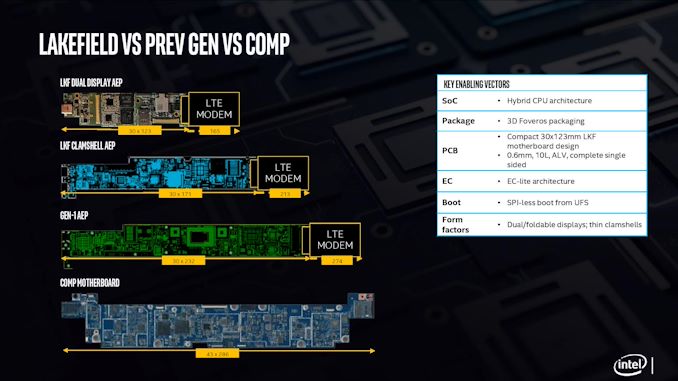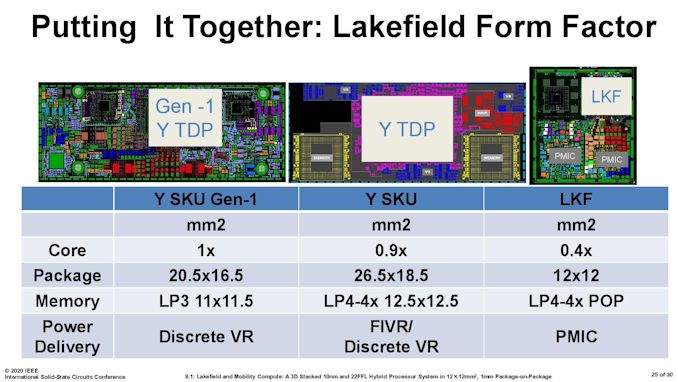The Intel Lakefield Deep Dive: Everything To Know About the First x86 Hybrid CPU
by Dr. Ian Cutress on July 2, 2020 9:00 AM ESTLakefield in Terms of Laptop Size
In a traditional AMD or Intel processor designed for laptops, we experience two to eight processing cores, along with some graphics performance, and it is up to the company to build the chip with the aim of hitting the right efficiency point (15 W, or 35/45 W) to enable the best performance for a given power window. These processors also contain a lot of extra connectivity and functionality, such as a dual channel memory controller, extra PCIe lanes to support external graphics, support for USB port connectivity or an external connectivity hub, or in the case of Intel’s latest designs, support for Thunderbolt built right into the silicon without the need for an external controller. These processors typically have physical dimensions of 150 square millimeters or more, and in a notebook, when paired with the additional power delivery and controllers needed such as Wi-Fi and modems, can tend towards the board inside the system (the motherboard) totaling 15 square inches total.

One of Qualcomm’s examples from 2018
For a Qualcomm processor designed for laptops, the silicon is a paired down to the essentials commonly associated with a smartphone. This means that modem connectivity is built into the processor, and the hardware associated with power delivery and USB are all on the scale of a smartphone. This means a motherboard designed around a Qualcomm processor will be around half the size, enabling different form factors, or more battery capacity in the same size laptop chassis.
With Intel’s new Lakefield processor design, the chip is a lot smaller than previous Intel implementations. The company designed the processor from the ground up, with as much included on the CPU as to not need additional chips on the motherboard, and to fit the dimensions similar to one of Qualcomm’s processors. Above is a slide showing how Intel believes that with an LTE modem included, a Lakefield motherboard can move down to 7.7 square inches, similar to a Qualcomm design. This leaves more room for battery inside a device.
When Intel compares it against its own previous low power CPU implementations, the company quotes a 60% decrease in overall board area compared to its first generation 4.5 W processors.
It is worth noting that for power delivery, Intel placed MIMCAPs inside the Lakefield silicon, much like a smartphone processor, and as a result it can get by on the power delivery implementation with a pair of PMICs (power management ICs). The reason why there is two is because of the two silicon dies inside – they are controlled differently for power for a number of technical reasons. If each layer within an active stacked implementation requires its own PMIC, that would presumably put an upper limit on future stacked designs – I fully expect Intel to be working on some sort of solution for this for it not to be an issue, however that wasn’t implemented in time for Lakefield.
For those that are interested, Lakefield’s PMICs are under the codenames Warren Cove and Castro Cover, and were developed in 2017-2018.












221 Comments
View All Comments
Tomatotech - Friday, July 3, 2020 - link
personal use computers (laptop / phones / etc) have a hell of a lot going on behind the scenes with constant and multiple cloud interactions and updates. Apple manages with tiny amounts of RAM on their phones because they have an obsessive focus on cutting out cruft and streamlining iOS. MacOS and Windows? Not so much. 8GB is needed for futureproofing.If Microsoft is able to revamp Windows on iOS lines then maybe 6GB or 4GB, but Apple themselves have set 8GB as a minimum for for all new MacOS computers, and they are a company that has a history of not putting enough RAM in their cheaper offerings.
As for the new ARM Mac computers, we will see, but it's unlikely they will have less than 8GB. 16GB minimum is a strong possibility for various reasons when they come out in 2021-ish. IF, and it's a BIG IF, Apple releases a new ultra-long-life device running a mix of MacOS and iOS, then the battery difference of running less RAM might swing it, but we're firmly in making-stuff-up land now.
nonoverclock - Friday, July 3, 2020 - link
Corporate laptops are sort of a different story with all of their agents running. Definitely need more resource to handle all that. On a basic home laptop with Office and a few other apps, most people could probably do ok with 8 GB.Lucky Stripes 99 - Saturday, July 4, 2020 - link
Agreed. My personal laptop has fewer than a third of the processes and half of the services of what my work laptop has at bootup. The encrypted filesystem is an especially nasty resource hog. I never seem to have a fast enough work laptop with all of that stuff.ProDigit - Friday, July 3, 2020 - link
Then run linux, like ubuntu.dotjaz - Saturday, July 4, 2020 - link
So what? Ryzen 4300U can be configured to 10W or lower if they want to complete with it. Besides Van Gogh is around the corner, it's almost certainly a native Quad-core part with RDNA2 for 15W and below. 7W is certainly within reach especially considering 3200U could do that.Skydanthology - Thursday, July 2, 2020 - link
Yeah, this is for ultra-mobile laptops or dual-screen tablets that require the lowest standby power. Besides, AMD also uses an older process node when making I/O or memory contollers.eek2121 - Thursday, July 2, 2020 - link
Not for mobile.ikjadoon - Thursday, July 2, 2020 - link
They said "ultra-mobile laptops"...which is exactly Lakefield's target."Lakefield processors are the smallest to deliver Intel Core performance and full Windows compatibility across productivity and content creation experiences for ultra-light and innovative form factors."
Literally from Intel: https://newsroom.intel.com/news/intel-hybrid-proce...
jeremyshaw - Thursday, July 2, 2020 - link
It's already somewhat covered in the article, however 22FFL =/= Intel's old "22FinFET". Intel's 22nm FinFET is closer to other foundries' 16/14/12nm FinFET anyways*, so it's strange you aren't bashing AMD for being behind the times on their 14/12nm IOD.*This is roughly when the "Intel N-1 node is equal to TSMC/Samsung/GF's N node" started, FWIW. Some say it was 32nm when it really started, but we can all agree that by 22nm, Intel really pulled ahead for a bit. Well, part of that was due to TSMC and GF fumbling badly at 32/28nm, but that somewhat dilutes the metric, anyways.
Jorgp2 - Thursday, July 2, 2020 - link
>Surely they are not going to go back to 22nm? The packaging engineering is interesting enough, but there seems to be no fundamental architecture improvements. I see Zen-xx crushing this straight out the gate. Definitely not adaptable for desktop use.And?
AMD was using a similar node until last year.